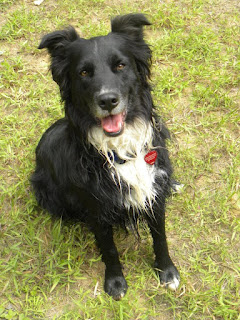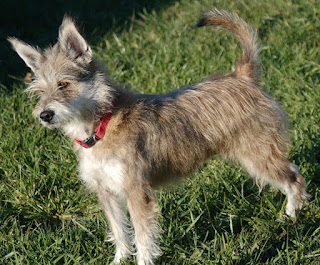The Positive Paw pack just moved from the beautiful mountains of western North Carolina to eastern North Carolina
We have been in our new home for less than 48 hours and I thought this would be a good time to discuss ways to help your pack transition better when and if you have to move:
- Crate training really helps!
My dogs were crated far more than usual for several days while we loaded the Uhaul (I didn’t want anyone slipping out the door and into the road!), drove (the dogs don’t ride loose in the car – see the entries on “My Not So Excellent Adventure” and “This is How We Roll”) and unloaded. Luckily my dogs are very used to and comfortable in their crates, so this extended crate time didn’t stress them out. In fact, in light of all the chaos going on around them being crated actually helped them to settle and relax. It also allowed me to focus on packing and loading efficiently instead of worrying about the pups.
Once we were unloaded in the new house, I brought the dogs in and they all ran back into their crates. I had to laugh because this was after spending the night (while we stayed at a hotel) and most of the day in the car!! I didn’t shut the doors, but it was great to know that after all that time crated, they came into the new house and were reassured to find their crates. In a changing situation, they view their crates as their “safe place” and spot to relax. Of course, you could do the same thing with a dog bed but the real advantage to the crate is that you can shut the door and have that added protection of knowing your dog is confined when you need it.
At home, my dogs aren’t normally crated during the day but I am crating them when I go out right now. We have moved from a very rural setting to one with neighbors. Crating them when I leave means they can’t practice any undesirable behaviors like standing up and looking out the windows or barking at the neighbors or birds in the backyard while I am gone. Once we are all comfortable in the new house, I’ll gradually transition back to not crating during the day.
- Provide happy constructive activities to keep your dog busy and entertained.
Since the dogs were spending *way* more time in their crates than usual, I focused on giving them plenty of good chewing opportunities (recreational raw bones are the norm in my house but you could stuff kongs or any other treat dispensing toy). I did a tiny bit of trick training before each meal to give each of them a little individual interaction (usually it was just a couple of repetitions behaviors they already know like sit, lie down, high five, touch, rollover). I also sacrificed a couple of small cardboard boxes, paper towel rolls and some newspaper for the girls to run around with, tear up and destroy.
- Aim for as much consistency as you can.
I tried to keep my pets’ routines as normal as possible. For the dogs, this meant getting out for a little walk in the usual places – even if we couldn’t go as far or as long as normal. I also tried to make time every night for the girls’ indoor playtime even though it had to be shortened (sometimes it was only a couple of minutes long). For Ben, I made it a point not miss evening snuggle time – even if it was for just a minute or two. For the cats, it meant leaving them in my old house for a couple of days after everything was packed even though I was staying with a friend. This way, I wasn’t bouncing them between multiple houses.
- Small spaces make transitions easier for cats.
The cats were shut in a single room while we were loading the Uhaul. My cats are indoor only at this point so they were easy to find and confine. If you have indoor/outdoor cats though, you many need to confine them before you start packing since nervous cats may be difficult to find for days at a time. (If Stella had access to the out of doors, I would have confined her before packing the first box since she is very flighty about any change in the routine.)
During the actual drive, the cats were confined to large dog crates with small litter boxes. I offered them food and water at each stop (they invariably spill the water if I leave it in the kennels while driving). This setup worked great, even when we had to stay in a hotel overnight since they had access to litter all the time, and water and food at regular intervals.
With the help of a friend, I was able to carry the crated cats right into the house and the “cat room” when we arrived. I shut the cats in their new room overnight to help them relax. It also helped them learn where the litter box, food and scratching posts were. Since this house is small, I was able to quickly transition them to having run of the house. The larger the house is though, the slower I give them access to new space. When we moved into the big house on the mountain, I gave them a new room every couple of days.
The speed of the transition depends largely on the personality of your cat. A more timid cat will be reassured by a slower transition (maybe even start out confining him to a bathroom) while a bold cat may not require as much time. (My cat Cleo is uber-confident and The Queen of Moving. She adjusts to almost any move within a day or so but she is a *rare* exception. This is also our sixth move together.) Too much space at once increases anxiety and the risk that your cat will hide, mark territory, scratch inappropriate objects or have litter box issues.
- Plan for the worst and manage, manage, manage.
If your critters have any issues, expect that the stress of the move will exacerbate them and be prepared. This way, you are one step ahead of the problem. If it doesn’t happen – great! But it’s always better to be safe than sorry – especially when your pet’s safety is at risk. No matter what your pet’s issue is (marking in the house, chewing, not coming when called, separation anxiety, etc), assume that the move will make it worse and take proactive steps to alleviate and manage the issue.
As much as I hated to leave all of my clients and their dogs behind in the mountains, I am excited about my job opportunity here. I will start teaching classes again after I have settled in but right now my goal is to focus on my dogs and working with them. I have realized that over the years, I spend so much time working with other people and their dogs that I have a tendency to come home and manage my dogs rather than actively changing their behaviors. While there is nothing inherently wrong with this, I look forward to working with and training my own dogs more.
Meanwhile, I’m still just a phone call or email away for my WNC clients. I will still be posting on Positive Paw (and Positive Paw on Facebook too). I will also be back in the mountains regularly to catch up with friends and hope to see some of “my puppies” then. So please contact me if you have any questions and I’ll keep you updated on how the Positive Paw pack is doing with our transition.











